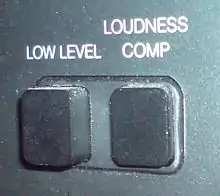Loudness compensation
Loudness compensation is a setting found on some hi-fi equipment that increases the level of the high and low frequencies.[1] This is intended to be used at low listening levels, to compensate for the fact that as the loudness of audio decreases, the ear's lower sensitivity to extreme high and low frequencies may cause these signals to fall below threshold.[2] As a result audio material may become thin sounding at low volumes, losing bass and treble. The loudness compensation feature (often just labelled loudness) applies equalization and is intended to rectify this situation.[3]

Correct loudness compensation required a calibrated system with known listening level. Audio level at a listener's ears depends on listening environment, listener position, speaker sensitivity as well as amplifier gain. For loudness compensation to work correctly the playback system must also accurately assume what volume level was used in the mastering location. For movie soundtracks this reference volume level is an industry standard[4] and can be used by manufacturers to provide a loudness feature that works with a reasonable degree of accuracy. A Home theater product that provides a reference level indication on the volume control can be expected to work well with movie soundtracks.
References
- "Audyssey Laboratories' Dynamic EQ". About.com - Stereos. Archived from the original on 2015-09-07.
- Bench, Steve (2004-09-07). "Pole Zero Analysis - Part 3 : Loudness Compensation". Steve's Vacuum Tube Related Web Site. Retrieved 2013-05-07.
- Foley, Mark. "Loudness And The Fletcher-Munson Curve". Retrieved 2018-10-01.
- SMPTE 202m-1998